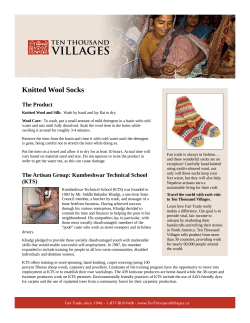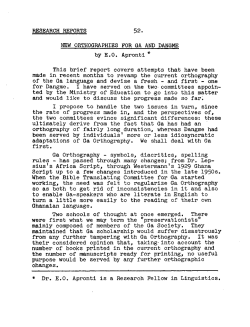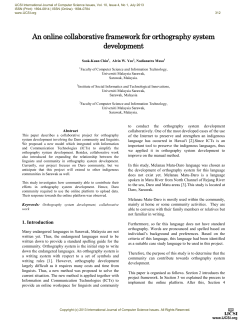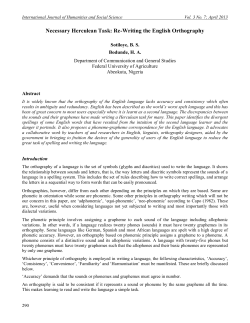
Writing of languages and Linguistic Survey of Nepal (LinSuN) Dr. Dan Raj Regmi
Writing of languages and Linguistic Survey of Nepal (LinSuN) Dr. Dan Raj Regmi Head Central Department of Linguistics Tribhuvan University, Nepal Director Linguistic Survey of Nepal danraj_regmi@hotmail.com 1 Organization • Section 1. Linguistic survey of Nepal: Vision, reason, main objectives, survey and survey reports • Section 2. Writing: Linguistic and social reality • Section 3. Issues of writing of languages in Nepal 3.1 Tibeto-Burman languages 3.2 Indo-Aryan languages and others • Section 4. Adaptation of Devanagari scripts • Section 5. The policy of LinSuN to develop orthographies for unwritten languages • Section 6: Summary 2 1. Linguistic survey of Nepal The linguistic survey of Nepal has been conducted under Central Department of Nepal with the aegis of National Planning Commission, Government of Nepal since 2009. 1.1 Vision “… to lay a foundation that provides for the linguistic rights of the citizens of Nepal so that all her people, regardless of linguistic background, will be included in the overall fabric of the nation.” 1.2 Rationale “…not sufficient understanding in the diversity of its people and the languages they speak. Even a full identification of the number of languages and dialects has not yet been possible. If efforts in linguistic inclusion will have any success, they must begin first with an understanding of the full extent of the linguistic and ethnic diversity of the country.” 3 1.3 Reasons To develop orthographies for unwritten or preliterate languages of Nepal To determine the role of language in primary and adult education To identify and document minority languages facing extinction, and To implement the socially inclusive provisions made in the Interim Plan, National Planning Commission 2007 4 1.4 Main objectives To develop a sociolinguistic profile of all the languages of Nepal To produce a basic description of at least ten languages (at least one description in each cluster) that includes an understanding of the sound system, observations on the grammar, and a trilingual glossary, To develop and maintain a complete database of the languages of Nepal, and To develop a description of the use of mother tongues in education (formal and non-formal) as a means to better understand the development needed for mother-tongue curricula in the national educational system. 5 1.5 Languages surveyed – Nepali: Indo-Aryan/ Devanagari script – Maithili : Indo-Aryan / Devanagari script/Mithilkshar – Newar:Tibeto-Burman / Devanagari script/ Ranjana – Chepang:Tibeto-Burman/preliterate – Bhujel:Tibeto-Burman/preliterate – Yakkha:Tibeto-Burman/preliterate – Lapcha:Tibeto-Burman/Rhong – Bote : Indo-Aryan/preliterate 6 1.6. Survey reports – Nepali – Maithili: Language use and attitudes – Newar : Language use and attitudes – Chepang : Language use and attitudes – Bhujel : Language use and attitudes – Yakkha : Language use and attitudes – Lapcha : Language use and attitudes – Bote : Language use and attitudes 7 1.7 Languages for MLE and writing system – Maithili : a long tradition of writing in Devanagari scripts – Newar : a long tradition of writing in Devanagari scripts – Chepang : Devanagari( proposed) – Bhujel : Devanagari ( proposed) – Yakkha : Devanagari ( proposed) – Lapcha : Rong – Bote : Devanagari ( proposed) 8 2. Writing: Linguistic and social reality (Robinson, 2003) • 2.1 Linguistic reality: representation of phonemic system of the language in question ( tone, breathy, glottal stops) • 2.2 Social reality : symbol of identity, culture, tradition, history, religion, politics – a social convention, to be adopted and used by a community of speakers with their particular history, social relations, political context and cultural heritage – Nowadays, in Nepal, the issue of the orthography has been seriously taken not only as socio-political matter but also as symbol of ethnic identity of the speakers 9 3: Issues of writing of languages in Nepal 3.1 Scripts used for the languages of Nepal Table 1: Scripts used for the languages of Nepal (Yadava, 2007) Scripts Languages 1 Devanagari Nepali, Maithali, Bhojpuri, Awadhi, Newari, etc 2 Sambota/Tibetian Tibetan/Sherpa 3 Ranjana Newar 4 Bhujimo Newar 5 Panchumo Newar 10 6 Golamo Newar 7 8 9 10 11 12 13 14 15 Litumo Kumo Sirijanga Rong Bangla/Bengali Tamu Akkha Arabi Roman Newar Newar Limbu Lepcha/ Lapcha Bangla/Bengali Gurung Magar Urdu English, Santhal, Gurung 11 3.2 Why writing systems? • Writing system in preliterate languages: – literacy – primary education in the mother tongue – standardization of the language itself • Does each language need separate writing system? • Develop a new writing system? • Is it alright with the adaptation of the scripts used in the languages of wider communication? • If adaptation, how to adapt and get consensus from the speech community? 12 • Choosing a script for more than 120 preliterate languages spoken in Nepal is an issue in recent years 3.1 Tibeto-Burman languages (57 languages) • Glover(2002): a detailed phonemic analysis and a detailed study of the dialectal variations of the language are required to suggest a script for the language • There are three script choices, viz. Tibetan, Devanagari and Roman for the unwritten TibetoBurman languages in Nepal • He notes that the Devanagari script may be the most suitable choice among the three. 13 • Chamberlain(2001) discusses orthography issues in the minority unwritten languages and notes that the Tibetan script is suitable for a language which has a high level of cognates with Tibetan and a sizable or influential population literate in Tibetan • For the rest of the Tibeto-Burman languages spoken in Nepal the Devanagari script can be adapted for writing • Hari (2000) notes that the Tibetan script is not able to represent the tonal features of a language like Yohlmo, a Tibeto-Burman language (Helambu Sherpa) and recommends the Devanagari script for the TibetoBurman languages like Yohlmo • The Devanagari script has been used in Yohlmo-NepaliEnglish dictionary published in 2004. 14 • Noonan (2005) : discusses the practical problems in proposing a writing system for unwritten languages of Nepal • He notes that though there may be other alternative scripts the Devanagari script can be adapted for all the unwritten Tibeto-Burman languages of Nepal • Choosing orthography for the preliterate language may be a great issue in the present context of Nepal • Roman script, though easy to follow, for the preliterate language because it is not practically adapted to any Tibeto-Burman languages in Nepal 15 • 3.2 Indo-Aryan languages (17) – Religion, culture, tradition – Religious scripts in Devanagari – Nepali, one of the languages of wider communication, in Devanagari scripts – Many Indo-Aryan languages written in slightly modified version of Devanagari: Gurumukhi, 16 4: Devanagari adaptation Table 1: Consonants that Devanagari can represent Consonants Unaspirated stop/affricate Aspirated stop /affricate Voiced stop/ affricate Murmured stop/ affricate Voiced nasal stop Voiced lateral Approximant Voiced tap Voiceless fricative Glottal fricative Glide Labial Den-Alv Retroflex Palatal Velar p ऩ् t त् ट् ts च ् k क् ph प् th थ ् H ठ् tsh छ् kh ख ् b फ् d द् ड् dz ज ् g ग् bh ब ् dh ध ् H ढ् dzh झ ् gh घ ् m भ् n न् Glottal ŋ ङ् l र् r य् s स् j म् w व् ह् 17 4.2 Motivations for Devanagari • • • • • • Tone and glottal stop are generally considered as the major difficult aspects of the phonological system of language. A very few languages have these features. The breathy phonemes seem difficult to accommodate in the Devanagari script but they can also be accommodated in the Devanagari script well The people , who are literate, are basically literate in the contact language Nepali. Thus, it is easy to follow for them Many words related to different semantic domains have been heavily borrowed from Nepali. They do not pose any difficulty to be written in Nepali. Some languages like Newar and Maithili which retain their own traditional scripts are also motivated to use Devanagari script and the Devanagari script has been proposed and adopted for the Tibeto-Burman languages of Nepal except a few languages like Limbu and Magar The numerals can easily be represented in the Devanagari script 18 Table 2: Breathy consonants in Devanagari script Breathy consonants rh lh nh mh ŋh yh wh Devanagari scripts र्ह ल्ह न्ह म्ह ङ्ह य्ह ह्व 19 5. The policy of LinSuN to develop orthographies for unwritten languages • • • • • • • 5.1.Despite the fact that script is symbol of the ethnic identity the following facts have to be considered in the use of orthography: Technology-friendly (Unicode) Sound system of the language Economy: as far as possible a few diacritics Easy to learn Facilitating in the learning the languages of the wider communication ( Maithili and Newar which had their traditional scripts are now written in Devanagari) Culture and tradition friendly Full consent of the speech community 20 5.2 Some polices of LinSuN in the development of orthography • Phonological analysis : inventory of the basic sounds • Choice of a better scripts in terms of features of the sounds • Interaction with the speech community as well as the experts • Orthography workshops for the speech community • Consensus of the speech community • Development of teaching and reading materials for mother tongue based MLE 21 6. Summary • To develop orthography for preliterate languages is not an easy task • Multidimensional factors to be considered: linguistic as well as social • Adaptation is also not an easy process • Devanagari for unwritten languages of Nepal: – Easy to adapt, – Facilitate to learn Nepali or any language of wider communication • Linguistic survey of Nepal: Propose orthography with the active participation of speech community as well as experts which will be technology friendly, culture and tradition friendly and linguistically significant. 22 References • • • • • • • Chamberlain, Brad. 2001. "Using Tibetan Characters for Minority Language Orthography."Paper presented at the 22nd annual conference of Linguistic Society of Nepal. Glover,Warren. 2002. "Choosing a Gurung Orthography for a New Dictionary." Gipan: TU papers in Linguistics 2: 25-38. Hari, Anna Maria. 2000. " Orthography Issues in Tibeto-Burman Languages of Nepal." Paper presented at the 21st annual conference of Linguistic Society of Nepal, Kathamndu. Noonan, Michael. 2005a. "Recent Adaptations of the Devanagari Script for the Tibeto-Burman Languages of Nepal." <http://www.uwm.edu/~noonan/Recent%20 Adaptions%20of%20the%20Devanagari%20Script%20for%20the.pdf.> Gurung, Hark; Yogendra Gurung; and Chhabi Lal Chidi.2006. Nepal Atlas of Language Groups. Lalitpur: National Foundation for Development of Indigenous Nationalities ( Regmi, Dan Raj. 2007. The Bhujel Language. A Ph.D Dissettation, T.U. Robinson, Clinton (with Karl Gadelii) 2003: "Writing Unwritten Languages." <http://www.portal.unesco.org/ education/ev.php?> 23
© Copyright 2025





















